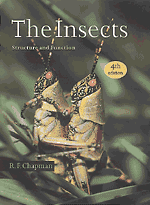Book contents
- Frontmatter
- Contents
- Preface
- Acknowledgments
- PART I The Head, Ingestion, Utilization and Distribution of Food
- PART II The Thorax and Locomotion
- PART III The Abdomen, Reproduction and Development
- 11 Abdomen
- 12 Reproductive system: male
- 13 Reproductive system: female
- 14 The egg and embryology
- 15 Postembryonic development
- PART IV The Integument, Gas Exchange and Homeostasis
- PART V Communication
- Taxonomic index
- Subject index
11 - Abdomen
Published online by Cambridge University Press: 05 June 2012
- Frontmatter
- Contents
- Preface
- Acknowledgments
- PART I The Head, Ingestion, Utilization and Distribution of Food
- PART II The Thorax and Locomotion
- PART III The Abdomen, Reproduction and Development
- 11 Abdomen
- 12 Reproductive system: male
- 13 Reproductive system: female
- 14 The egg and embryology
- 15 Postembryonic development
- PART IV The Integument, Gas Exchange and Homeostasis
- PART V Communication
- Taxonomic index
- Subject index
Summary
The insect abdomen is more obviously segmental in origin than either the head or the thorax, consisting of a series of similar segments, but with the posterior segments modified for mating and oviposition. In general, the abdominal segments of adult insects are without appendages except for those concerned with reproduction and a pair of terminal, usually sensory, cerci. Pregenital appendages are, however, present in Apterygota and in many larval insects as well as in non-insectan hexapods. Aquatic larvae often have segmental gills, while many holometabolous larvae, especially amongst the Diptera and Lepidoptera, have lobe-like abdominal legs called prolegs.
Reviews: Bitsch, 1979; Matsuda, 1976; Snodgrass, 1935
SEGMENTATION
Number of segments
The basic number of segments in the abdomen is eleven plus the postsegmental telson which bears the anus, although Matsuda (1976) regards the telson as a twelfth segment. Only in adult Protura and the embryos of some hemimetabolous insects is the full complement visible. In all other instances there is some degree of reduction. The telson, if it is present at all, is generally represented only by the circumanal membrane, but in larval Odonata three small sclerites surrounding the anus may represent the telson.
In general, more segments are visible in the more generalized hemimetabolous orders than in the more specialized holometabolous insects. Thus in Acrididae all eleven segments are visible (Fig. 11. 1a) whereas in adult Muscidae only segments 2–5 are visible and segments 6–9 are normally telescoped within the others (Fig. 11.1b).
- Type
- Chapter
- Information
- The InsectsStructure and Function, pp. 259 - 267Publisher: Cambridge University PressPrint publication year: 1998



